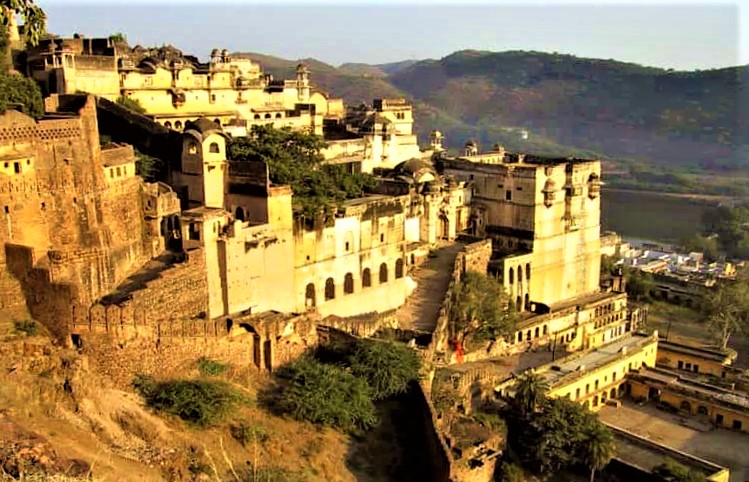Peace Propagators (Part 4): Khawaja, the Mystic Saint of Rajasthan
TRANSCEND MEMBERS, 3 Apr 2023
Prof Hoosen Vawda – TRANSCEND Media Service
The World Needs More Humanoids with Enlightened Brains[i]
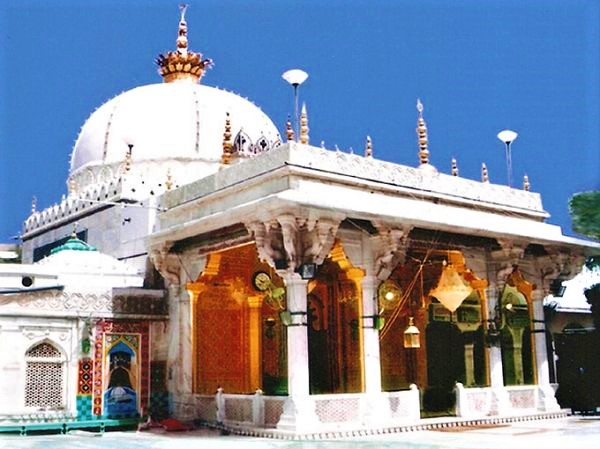
Peace Enclave in present day Ajmer – The Shrine of the Mystic Saint, Hazarath, Khawaja Moinuddin Chishti
This publication, Part 4 in the series on Peace Propagators, discusses the personal, community and global contributions made by a little know, simple and initially unrecognized mystic saint, in the Kingdom of Rajput, over the centuries and was instrumental in effecting inter religious dialogue between Hindus and Muslims in ancient India. The Khawaja of Ajmer refers to the revered Sufi saint, Khawaja Moinuddin Chishti, who is also known as Garib Nawaz (protector of the poor). He was born in 1142 CE in Sistan, a region in present-day Iran. This mystic even today, is called by the name of “Khawaja” which is an honorific title used across the Middle East, South Asia, Southeast Asia and Central Asia, particularly towards Sufi teachers. It is also used by Kashmiri Muslims[1] and the Mizrahi Jews, particularly Persian Jews and Baghdadi Jews.[2] The word comes from the Iranian word khwāja (Classical Persian: خواجه khwāja; Dari khājah; Tajik khoja). The spellings hodja or hoca (Turkish), খাজা (Khaaja) (Bengali), hodža (Bosnian), hoxha (Albanian), хоџа (Serbian), χότζας (chótzas) (Greek), hogea (Romanian), koja (Javanese).[3] The name is also used in Egypt and Sudan to indicate a person with a foreign nationality or foreign heritage. However, “The Khawaja” is the name of Khuwaja Ghareeb Nawaz and his official name is Hassan Chishti Ajmayri. He was born at Sanjar in Saijistan or Seestaan into a prestigious and educated family.
Ajmer was originally known as Ajayameru. The city was founded by an 11th century Chahamana King Ajaydeva. Historian Dasharatha Sharma notes that the earliest mention of the city’s name occurs in Palha’s Pattavali, which was copied in 1113 CE (1170 VS) at Dhara. This suggests that Ajmer was founded sometime before 1113 CE[4]. A prashasti (eulogistic inscription), issued by Vigraharaja IV and found at Adhai Din Ka Jhonpra (Sanskrit college), states Ajayadeva (that is Ajayaraja II) moved his residence to Ajmer.[5]
He was bestowed and called by numerous titles. His famous titles include Mu’eenuddin, Ghareeb Nawaz, Sultan-ul-Hind, and Atta-e-Rasool, Mu’een-ul-Hind Hazrat Khuwajah Mu’eenudin Ajmayri.[6] Like a genuine mystic, Khwaja Ghareeb Nawaz spent most of his life traveling and acquiring knowledge and in the company of the great Saints of his time. He met with his Spiritual Guide (Murshid) Hazrat Khwaja Usman Harooni when he was in his early twenties and made the Spiritual Contract (Bai’ah) with him. He traveled and acquired much spiritual benefit from his Murshid. His travels also took him to Lahore where he visited the tomb of Hazrat Shaykh Ali Hujweri famous as Hazrat Daata Ganj Bakhsh. He also travelled Syria, Baghdad and Kirman, to gaining knowledge. During the visit of Haramayn he was blessed with the sainthood of India from the blessed court of Risalat and was ordered to serve and propagate Islam in India in a peaceful manner. With his excellent manners, exemplary character and speech, he propagated Islam in this region, which was predominantly Hindus, resulting in hundreds of thousands of people embracing Islam voluntarily, wherever, he travelled.
A story often narrated demonstrated his superb character, Once, a disbeliever came with the intention of killing Sayyiduna Khuwajah Ghareeb Nawaz, holding a dagger in the armpit. He sensed his intention through his spiritual intellect. When the person approached closer, Sayyiduna Khuwajah Ghareeb Nawaz exclaimed, ‘Put your task into action, I am present in front of you.’ Having heard these words, that person started trembling. He took out the dagger, cast it away and threw himself at the feet of Sayyiduna Khuwajah Ghareeb Nawaz. He repented earnestly and became Muslim. Through reformation and preaching, he prepared such a group of students and Khulafa that carried out the great duty of serving Islam everywhere in the Indian subcontinent. He also carried out the duty of serving Islam and reforming people through his writings and books. In his books, one can find the mention of Anees-ul-Arwah, Kashful Asraar, Ganj-ul-Asraar and Deevan-e-Mu’een. Khuwaja Ghareeb Nawaz approximately spent 45 years serving Islam in India.
At a young age, Khawaja Moinuddin Chishti received education from renowned scholars in his hometown. He became a disciple of Khawaja Usman Harooni, a prominent Sufi saint of his time. After completing his spiritual training, Khawaja Moinuddin Chishti embarked on a journey of spreading the teachings of Islam and Sufism. In 1191 CE, Khawaja Moinuddin Chishti arrived in India and settled in Ajmer, a city located in present-day Rajasthan. He soon gained a large following of devotees from all walks of life, including Hindus, Muslims, and Sikhs. He preached the message of love, peace, and harmony among all religions and sects.
Khawaja Moinuddin Chishti established a Khanqah, a Sufi spiritual center, in Ajmer, where he lived and taught his disciples. He also established a tradition of langar, a community kitchen where free food is served to all visitors, regardless of their religion or social status. Overlooking the city of Ajmer, is the Taragarh Hill. The Taragarh Fort is a fortress built upon a steep hillside in the city of Ajmer in the Indian state of Rajasthan. It was constructed in the 8th century by Ajayaraja Chauhan (721–734)[7] and it was originally called Ajaymeru Durg.[8]
The fort in Ajmer is known as Taragarh Fort, which was built in the 14th century by King Ajaipal Chauhan, the founder of Ajmer. It is located on a hill, known as Nagpahari or Snake Mountain, in the Aravalli Range. The fort is also called the “Star Fort” because of its unique star-shaped layout. Taragarh Fort was built to protect the city of Ajmer from invasions, and it served as a military base for many centuries. The fort is divided into several sections, including the main palace, the Rani Mahal (Queen’s Palace), and the Mughal Garden. The fort also houses several temples, including the Ajaypal Temple, dedicated to the fort’s founder. The fort offers a magnificent panoramic view of the city of Ajmer and the surrounding hills. The walls of the fort are adorned with intricate carvings and paintings, reflecting a blend of Hindu and Islamic styles. Visitors can explore the underground passages and tunnels that were used for military purposes.
The hill in Ajmer refers to the Aravalli Range, which is the oldest mountain range in India. It is spread over a large area and is home to several ancient temples, including the Nareli Jain Temple, the Adhai Din Ka Jhonpra Mosque, and the Ana Sagar Lake. The hill also offers stunning views of the city of Ajmer and the surrounding landscape.
The Aravalli Range is also a popular destination for trekking and hiking, with several trekking trails available for visitors. It is home to several wildlife sanctuaries and national parks, including the Sariska Tiger Reserve and the Ranthambore National Park, which are popular among wildlife enthusiasts. The Aravalli Range is a must-visit destination for nature lovers and offers a unique experience of the natural beauty of Rajasthan. The Taragarh Fort was known for its strength and strategic importance. First attack on this fort was made by Muhammad of Ghazni in 1024 AD. He laid down the siege, was wounded and failed to take the fort.[9] Prithviraj, son of Rana Raimal of Mewar and elder brother of Rana Sanga, captured Taragarh fort of Ajmer during the end of 15th century, after slaying Governor Mallu Khan.[10] The fort is also called Taragarh, named after Prithviraj’s wife Tarabai.[11] It remained under control of Mewar and later Rana Sanga granted it to Karamchand Panwar.[12]
Khawaja is revered by Muslims and Hindus alike and is known for his many miracles, peace propagation and acts of kindness during his lifetime, and beyond. The following miracles were performed by Khawaja of Ajmer and attributed to him:-
- Healing the sick: Khawaja of Ajmer was known for his ability to heal the sick. Many people came to him with various ailments, and he would pray for them and touch them, and they would be healed. It is said that he even brought some people back from the brink of death.
- Feeding the hungry: Khawaja of Ajmer was also known for his compassion and generosity. He would often feed the hungry, and it is said that he miraculously fed thousands of people with just a few loaves of bread.
- Quelling a storm: One of the most famous miracles attributed to Khawaja of Ajmer is the quelling of a storm. It is said that he was on a boat with his disciples when a fierce storm arose. He prayed for the storm to stop, and it immediately calmed down, saving the lives of everyone on the boat.
- Bringing a dead child back to life: According to legend, a woman came to Khawaja of Ajmer with her dead child, begging him to bring the child back to life. Khawaja of Ajmer prayed for the child and touched him, and the child miraculously came back to life.
- Turning water into milk: Another famous miracle attributed to Khawaja of Ajmer is the turning of water into milk. It is said that he was once in a village where there was no milk, and he prayed for God to provide milk for the people. Suddenly, water in a nearby well turned into milk, and the people were able to drink and be nourished.
- Khawaja Ajmer visit is mentioned as full of miracles. Reaching Ajmer, he decided to sit under a tree, but camel keepers ordered him away as the area belonged to the King. The camel keeping area was King Prithviraj’s army area, in which locals were not allowed. A narration emerged, that due to this incident and being prevented from resting in the camel resting area, Khawaja wished that none of the camels were able to stand on their legs. It was only when the King’s officials came and pleaded for assistance, that Khawaja made the camels stand up and move.
These are just a few of the many miracles attributed to Khawaja of Ajmer. His legacy of compassion, generosity, and spiritual insight continue to inspire people to this day. It is also important to note that the miracles are even ongoing, even after his demise and in the 21st century. Presently, outside the mausoleum of Khawaja in Ajmer, there is a huge cauldron which is used to feed hundreds of thousands of pilgrims to the shrine during the Urs Celebrations in Ajmer.
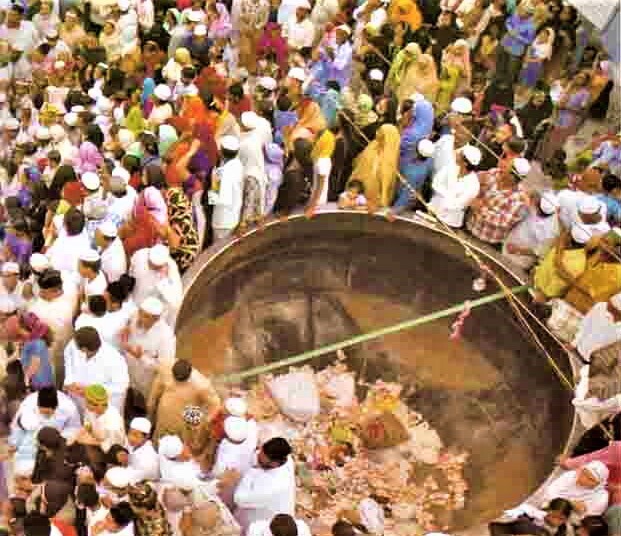
One of The Degh’s (Cauldrons) Services for Ajmer, Dargah Khwaja Gharib Nawaz Ajmer, Rajasthan, India
Inside Dargah (Shrine Complex), Ajmer two big Deghs (Pots, Cauldrons) are installed for cooking Niaz (Offerings) purely vegetarian food; cooked with rice, ghee, nuts, safron & sugar. The system of cooking food in cauldron (Degh) was first introduced by Akbar. Since then a large quantity of food of different kinds has always been cooked in Deghs generally at night, and is distributed among the people after Fajr (morning) prayers.[13]
Tomes Coryat[14], who visited Ajmer, at the time of Jahangir, says that the Mughal emperor once ordered the preparation of Khichri in the Degh to be distributed among 5000 people, taking out the first on a platter with his own hands, followed by the Queen, Noor Jehan, and other ladies of the Harem. Once, Shah Jahan mixed the meat of a Nilgai (one of the species of antelope) in the preparation of Degh, which he had shot during a hunting expedition. In the second half of the eighteenth century, when Ajmer came under the control of the Marathas and Rajputs, a new kind of food known as Kesaria Bhat (saffroned sweet rice) was cooked in these Deghs and that has continued to this day. Another smaller Degh, or cauldron, was presented by Emperor Akbar[15], 2400 kgs of food can be cooked in it that approximately amounts to 60,000.00 Indian Rupees. Big Degh : It was presented by Emperor Jahangir[16], 4800 kgs of food can be cooked in it and the cost comes to about 120,000.00 Indian Rupees. All these Deghs are cooked by Zaireen (pilgrims/devotees) who can afford to cook, Bavakalat (through) respective Khadims of Khwaja Gharib Nawaz. If anyone has a plan to cook Degh at any time of the year, It can be cooked in their personal presence and also in absence, on their behalf, has a capacity of 7070 kg and is used during special occasions and festivals to prepare food for an even larger number of people. In addition to these cauldrons, there are also smaller ones used for making tea and distributing food to the poor and needy. These cauldrons are considered to be sacred and are believed to bring blessings to those who contribute towards their upkeep and maintenance, as well as sponsor food to the needy, to be cooked therein. These cauldrons in Ajmer are an important part of the shrine’s (Dargah’s) tradition and serve as a symbol of communal harmony, generosity, and compassion over the centuries.
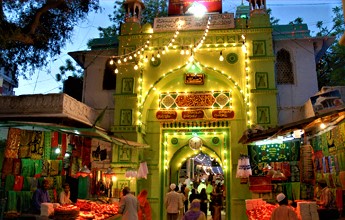
The main entrance gate into the Shrine Complex of Khawaja, in Ajmer, decorated for the Saint’s Urs (Death Anniversary) , up to the present day, as an annual event.
Khawaja Moinuddin Chishti passed away in 1236 CE, but his legacy continues to live on. The Dargah Sharif, his shrine in Ajmer, is visited by millions of devotees from all over the world every year, especially during the annual Urs (death anniversary) celebrations. The Khawaja of Ajmer is considered to be one of the most important Sufi saints in South Asia, and his teachings continue to inspire people to this day. Finally, this fountain of wisdom, knowledge and guidance departed this world on 6th Rajab 627 H in Ajmer Sharif (Rajasthan, India). His luminous shrine is situated in Ajmer Shareef. The mausoleum is located in the heart of Ajmer and is surrounded by a large courtyard. The entrance to the shrine is marked by a massive gateway known as the Nizam Gate, which was built in the early 20th century. The mausoleum itself is a beautiful example of Mughal architecture, with intricate carvings and decorations adorning its walls and ceilings.
Inside the mausoleum, there is a large central chamber that houses the tomb of Khawaja Moinuddin Chishti. The chamber is decorated with gold and silver ornaments, as well as colorful textiles and flowers. Visitors to the shrine can offer prayers and seek blessings from the saint, and it is believed that doing so can bring good fortune and help to overcome difficulties in life.
The Shrine of Khawaja Moinuddin Chishti is an important religious site in India, and it is also a symbol of the country’s rich cultural heritage. It attracts people of all faiths, and is an example of the peaceful coexistence of different religions in India.
The Bottom Line is that mystics, like Khawaja Moinuddin Chishti were mortals and subject to the biological processes affecting all humanoids. Finally, this fountain of wisdom, knowledge and guidance departed this world on 6th Rajab 627 H in the Islamic calendar, in Ajmer, Rajasthan, India. He passed away in 1236 CE, but his legacy continues to live on. The Dargah Sharif, his shrine in Ajmer, is visited by millions of devotees from all over the world every year, especially during the annual Urs (death anniversary) celebrations. The Khawaja of Ajmer is considered to be one of the most important Sufi saints in South Asia, and his teachings continue to inspire people to this day. His luminous shrine is situated in Ajmer.
The living legacy of Khawaja Moinuddin Chishti is omnipresent today and encompasses many different aspects of society and culture. This can be highlighted as follows:-
- Spiritual and Religious: Khawaja Moinuddin Chishti was a Sufi saint who preached a message of love, peace, and harmony. His teachings emphasized the importance of inner purification and the cultivation of moral and ethical virtues. His legacy lives on through the continued practice of Sufism and the influence of his teachings on the Islamic faith.
- Social and Humanitarian: Khawaja Moinuddin Chishti was known for his compassion and generosity towards the poor and needy. He established a langar (community kitchen) at his shrine in Ajmer that still serves free meals to thousands of people every day. His legacy inspires many social and humanitarian initiatives, particularly in the areas of poverty alleviation and community service.
- Cultural and Artistic: Khawaja Moinuddin Chishti played a significant role in the development of Indo-Islamic culture and art. He was a patron of music, poetry, and dance, and his shrine is known for its qawwali performances and other forms of devotional music. His legacy has influenced the development of many art forms in India, particularly in the areas of music and literature.
- Political and Diplomatic: Khawaja Moinuddin Chishti was known for his ability to bridge cultural and religious divides. He had a significant influence on the political and diplomatic relations between Hindus and Muslims in medieval India. His legacy continues to inspire efforts to promote interfaith dialogue and understanding in contemporary times.
The essence of presence of Khawaja’s philosophy in the 21st century, is one of eternal peace and harmony, across all religions, cultures, nations, genders and social standing. This is aptly demonstrated by the millions of global visitors from different religions, who visit the shrine, not only to achieve inner peace, as did the author, but also to be granted their wishes and blessing, through the intercession and good heartedness of the Saint Khawaja, over hundreds of years and still applicable as well as ongoing.
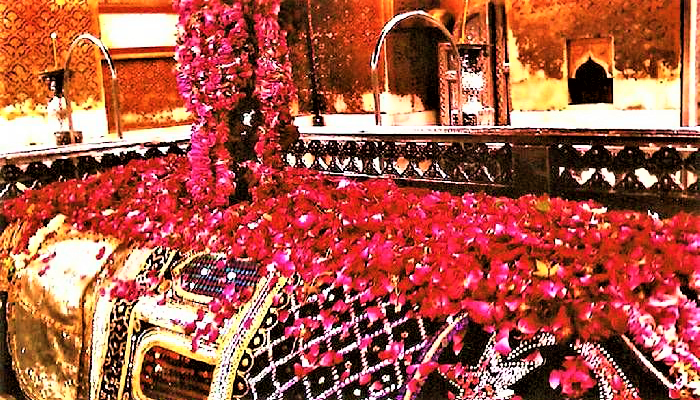
The Sanctorum Santorum; The actual Grave of Khawaja inside the shrine in Ajmer, draped in exquisite and expensive covers of fresh flowers, embroidery in gold and silver, embedded in precious and semi-precious jewels, from pilgrims whose wishes materialized after devout prayers at the graveside, irrespective of their religion.
References:
[i] Personal quote by the author, March 2023.
[1] https://books.google.com/books?id=-yUy7QpJp7MC&pg=PA23
[2] https://en.wikipedia.org/wiki/Khawaja_Shaikh#:~:text=Husain%2C%20Ruquiya%20K.%20(2004).%20%22KHWAJA%20ISRAEL%20SARHAD%3A%20ARMENIAN%20MERCHANT%20AND%20DIPLOMAT%22.%20Proceedings%20of%20the%20Indian%20History%20Congress.%2065%3A%20258%E2%80%93266.%20ISSN%C2%A02249%2D1937.
[3] https://en.wikipedia.org/wiki/Khawaja_Shaikh#:~:text=Husain%2C%20Ruquiya%20K.%20(2004).%20%22KHWAJA%20ISRAEL%20SARHAD%3A%20ARMENIAN%20MERCHANT%20AND%20DIPLOMAT%22.%20Proceedings%20of%20the%20Indian%20History%20Congress.%2065%3A%20258%E2%80%93266.%20ISSN%C2%A02249%2D1937.
[4] https://en.wikipedia.org/wiki/Ajmer#CITEREFDasharatha_Sharma1959
[5] https://en.wikipedia.org/wiki/Ajmer#CITEREFHar_Bilas_Sarda1911
[6] https://www.dawateislami.net/blog/khwaja-ghareeb-nawaz
[7] https://en.wikipedia.org/wiki/Taragarh_Fort,_Ajmer#:~:text=Tomars%20of%20Delhi%20by%20Harihar%20Niwas%20Dwivedi.%20Gwalior%3A%20Vidya%20Mandir%20Publication.%201983.%20p.%C2%A0175.
[8] https://en.wikipedia.org/wiki/Taragarh_Fort,_Ajmer#Sarda
[9] https://en.wikipedia.org/wiki/Taragarh_Fort,_Ajmer#Sarda
[10] https://en.wikipedia.org/wiki/Taragarh_Fort,_Ajmer#Sarda
[11] https://books.google.com/books?id=edofAAAAIAAJ
[12] https://en.wikipedia.org/wiki/Taragarh_Fort,_Ajmer#CITEREFDhoundiyal1966
[13] https://ajmerdargahsharif.com/#
[14] https://en.wikipedia.org/wiki/Thomas_Coryat
[15] https://www.culturalindia.net/indian-history/akbar.html#:~:text=Jalaluddin%20Muhammad%20Akbar%2C%20more%20famously%20known%20as%20Akbar,1556%2C%20at%20the%20tender%20age%20of%20just%2013.
[16] https://en.wikipedia.org/wiki/Jahangir
______________________________________________
 Professor G. Hoosen M. Vawda (Bsc; MBChB; PhD.Wits) is a member of the TRANSCEND Network for Peace Development Environment.
Professor G. Hoosen M. Vawda (Bsc; MBChB; PhD.Wits) is a member of the TRANSCEND Network for Peace Development Environment.
Director: Glastonbury Medical Research Centre; Community Health and Indigent Programme Services; Body Donor Foundation SA.
Principal Investigator: Multinational Clinical Trials
Consultant: Medical and General Research Ethics; Internal Medicine and Clinical Psychiatry:UKZN, Nelson R. Mandela School of Medicine
Executive Member: Inter Religious Council KZN SA
Public Liaison: Medical Misadventures
Activism: Justice for All
Email: vawda@ukzn.ac.za
Tags: Culture of Peace, Mysticism, Mystics, Peace Culture, Peace art, Peacebuilding, Poetry, Religion, Spirituality
This article originally appeared on Transcend Media Service (TMS) on 3 Apr 2023.
Anticopyright: Editorials and articles originated on TMS may be freely reprinted, disseminated, translated and used as background material, provided an acknowledgement and link to the source, TMS: Peace Propagators (Part 4): Khawaja, the Mystic Saint of Rajasthan, is included. Thank you.
If you enjoyed this article, please donate to TMS to join the growing list of TMS Supporters.

This work is licensed under a CC BY-NC 4.0 License.
